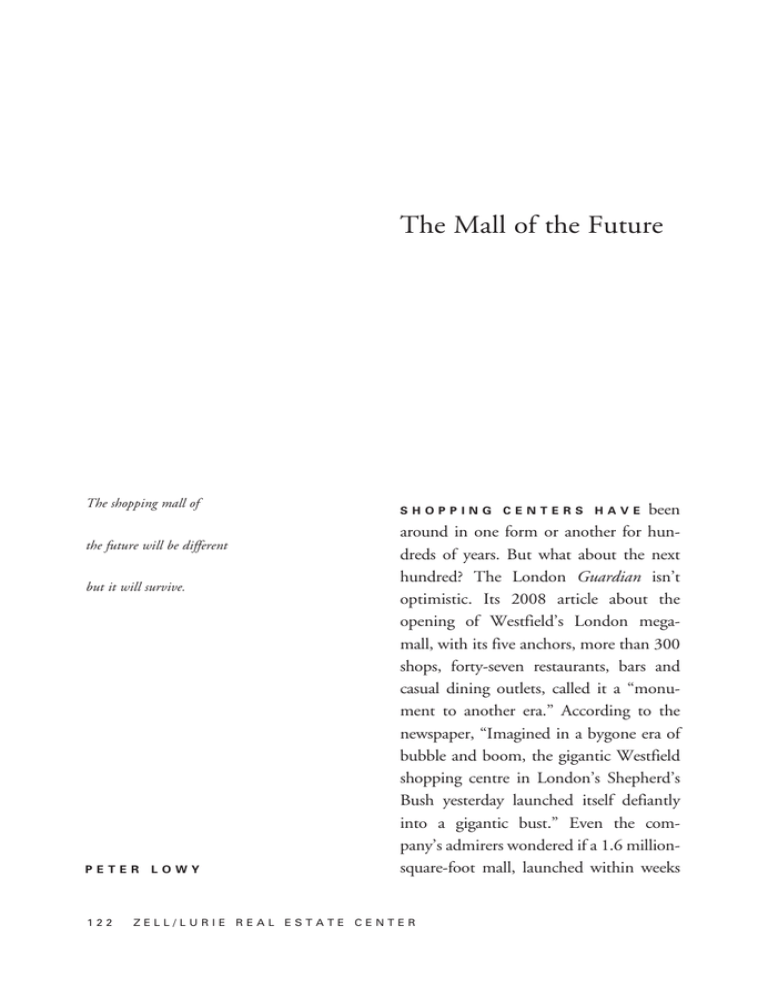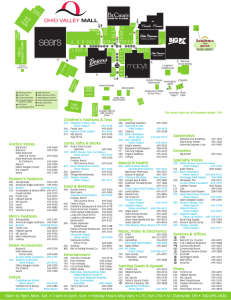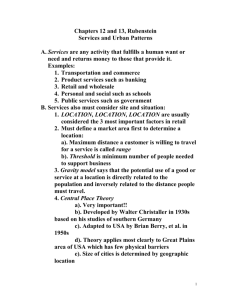The Mall of the Future
advertisement

The Mall of the Future The shopping mall of the future will be different but it will survive. PETER 122 LOWY been around in one form or another for hundreds of years. But what about the next hundred? The London Guardian isn’t optimistic. Its 2008 article about the opening of Westfield’s London megamall, with its five anchors, more than 300 shops, forty-seven restaurants, bars and casual dining outlets, called it a “monument to another era.” According to the newspaper, “Imagined in a bygone era of bubble and boom, the gigantic Westfield shopping centre in London’s Shepherd’s Bush yesterday launched itself defiantly into a gigantic bust.” Even the company’s admirers wondered if a 1.6 millionsquare-foot mall, launched within weeks SHOPPING CENTERS HAVE ZELL/LURIE REAL ESTATE CENTER of the greatest financial crash in sixty years, wasn’t a bridge too far, in an industry some analysts regard as overbuilt and past its prime. The skeptics were proved as wrong as they have been about the mall industry in general over the years. More than two years after it opened, Westfield London has been an unqualified success. Posted occupancy is 100 percent, annual traffic is in excess of 26 million and annual sales are £870 million. Some gigantic bust! For decades, the shopping mall industry has seen its obituary written many times. Sometimes it seems as if the first shopping mall came complete with the first shopping-mall skeptic! But to paraphrase Mark Twain, reports of the mall’s death have been greatly—and repeatedly—exaggerated. While the mall faces real challenges—and must adapt to changing times, tastes and technologies, its future is as promising as its past for the simple reason that its appeal is rooted in basic human needs and human behavior. WHAT IS A MALL? The Al-Hamidiyah Souq of ancient Syria is the antecedent of the shopping mall. The enclosed Damascus bazaar was replicated in Mediterranean market squares and seaports for centuries, reappearing as the enclosed arcades that were popu- lar in nineteenth-century European cities. Modern U.S. shopping centers, which include everything from small suburban strip centers to million-plus-square-foot super-regional malls, date from the 1920s, when shopping districts were developed to serve large suburban communities that developed along with the rise of the automobile. Prior to that time, American retailing was dominated largely by freestanding, inner-city department stores and downtown shops. Major U.S. shopping malls emerged in the early 1950s and 1960s, with various cities claiming to be home of the first: Seattle had Northgate (1951); Southfield, a suburb of Detroit, had Northland (1954); and Edina, a suburb of Minneapolis, had Southdale (1956). Sited away from dense, commercial downtowns in largely residential suburban market areas, the early malls featured enclosed, climate-controlled space with stores attached, and were accessible primarily by automobile. Relatively quickly, they became a popular way to build retail around the world. There are many types of shopping centers—ranging from smaller community, neighborhood and convenience centers to power strip and lifestyle centers, discount and outlet malls. For the purposes of this discussion, malls are generally defined as super-regional shopping centers of 800,000 square feet or more, incorporating three or more REVIEW 123 anchor stores and upward of 150 specialty shops, and drawing from a primary trade area of five to twenty-five miles. The 1960s and 1970s saw the sustained growth and development of fashion-oriented malls, usually anchored by two or more traditional department stores, and complemented by a burgeoning array of specialty retail shops and services, such as shoes, jewelry, home goods, and food. Early mall design tended to be inwardfacing, the better, it was believed, to entice consumers into a controlled shopping environment and keep them there. Similarly, the concept of anchoring the mall with one or more department stores was pioneered early, with individual shops or smaller-scale specialty retailers quickly realizing they could benefit from the consumer traffic attracted by the largeformat anchors. GROWTH AND MATURITY The 1980s saw explosive growth in the United States’ shopping center industry, which built more than 16,000 centers between 1980 and 1990, according to the International Council of Shopping Centers. Driving the growth were relatively good economic times and malls’ rising popularity among the shopping public. A 1990 Gallup poll found that people shopped at super-regional malls 124 and neighborhood centers more frequently than at any other format. An enduring feature of malls’ popularity has been fashion-oriented specialty retailers, which average about 2,500 square feet in size and concentrate on specific consumer markets and market segments such as women’s fashion, children’s shoes, teens/tweens, intimate apparel, athletics/ sportswear, and accessories. Offering variety, quality and value in a mall setting, many of these retailers have evolved over the years with new or revitalized products and larger and more sophisticated store formats. Some of the most prosperous U.S. specialty retailers literally grew up in the mall: for example, The Limited Brands, with its more than 3,080 stores worldwide and 2,678 U.S. stores; The Gap, with 2,545 U.S. stores and 537 units in Canada, the UK, France and Japan; Abercrombie & Fitch, with 1,067 U.S. stores and thirtyeight additional in Canada, Europe and Asia; and Forever 21, with more than 500 stores worldwide. Indeed, the success of these chains is almost unimaginable without malls. Now these established brands find themselves both challenged and complemented by the arrival of international competitors such as H&M and Zara. Foreign retailers have discovered they, too, can thrive in U.S. malls. As the mall industry matured through the 1980s and 1990s, new retail formats and merchandising concepts emerged to ZELL/LURIE REAL ESTATE CENTER drive sales even as the growth of new square-footage slowed. This included the introduction of off-price fashion retailers, category-killer stores like Bed, Bath & Beyond or Best Buy, outlet malls, and original specialty shop merchandise offerings. Both new and existing retailers identified or generated new market niches that could offer reasonable returns on capital. Nordstrom Rack, Pink, Apple, Abercrombie, PacSun, Torrid, Claire’s, and Aeropostale for example, have successfully identified key markets and capitalized on them. Some existing malls began to integrate these new concepts, enhancing the merchant mix and offering greater choice, value and convenience for the consumer. Early in the 1990s, a number of factors, including the dramatic growth and proliferation of new center construction in the previous period, as well as a difficult economy, the savings and loan crisis, and changing consumer tastes, prompted a significant decline in the new construction of large shopping malls. Between 1989 and 1993, the rate of new shopping center development dropped 70 percent, from 1,510 construction starts in 1989, to only 451 starts in 1993. One shopping format that grew in the early 1990s was the power center. Loosely defined as a center (usually outdoor) of between 250,000 and 600,000 square feet, the majority of the power center’s space houses category-specific offerings such as sporting goods, electronics, home improvement or toys, along with one or more destination anchors such as Costco, Target, Kohl’s, or Walmart. In 1993, sixteen new power centers opened in the United States compared to just four superregional malls. With few exceptions, most U.S. mall owners did not immediately recognize or respond to the risk presented by this new form of retailing. Often located near existing regional and super-regional malls, power centers siphoned off business from the malls as most mall owners, instead of incorporating these new ingredients into the mall environment, stuck to their traditional fashion orientation. This led to a deterioration in market share and declining appeal for many malls. For mall owners, 1993 was also notable for the transition of several privately-held, family-run shopping center development companies to publicly traded real estate investment trusts (REITs.) The resulting access to public capital provided a financial boost to the mall industry, which was still was recovering from the S&L crisis and the ensuing credit crunch. More challenges lay ahead. The late 1990s and early 2000s saw a sweeping retail consolidation during which major department stores were either acquired by stronger companies or merged. The merger/ acquisition of the May Department Stores REVIEW 125 company and Federated Department Stores (now Macy’s), in 2005 is one such example. Former iconic brands such as Hecht’s, Robinsons-May, Famous Barr, Meier & Frank and Marshall Fields all disappeared under the Macy’s umbrella. Consolidation left a smaller, but more financially solid, group of national department stores that functioned as lead anchors principally in fashion and apparel-oriented shopping malls. Ranging in size from 100,000 to 150,000 square feet, the leaders are Macy’s, Dillard’s, Neiman Marcus, Nordstrom and Saks, along with Sears and JCPenney, as well as mass-merchant Target, a relatively new addition to regional/super-regional malls. Consolidation, which might have seemed to some as a setback for mall landlords, presented a unique opportunity for shrewd mall owners to recover former department store real estate and reorient the merchandising mix with new anchors and other varieties of retail such as cinemas, big box category-specific stores, lifestyle elements, grocers, restaurants and more. United States shopping mall ownership experienced an industry consolidation of its own during the same period with the acquisition of multiple centers or takeover of mall portfolios by large public retail property companies. For some large portfolio owners such as Westfield, this was a time to focus on strategic acquisitions and dispositions in key U.S. markets, 126 but with a simultaneous concentration on redevelopment and expansion of existing assets, boosting profitability, strengthening market position and maintaining their relevance for consumers. Malls once again demonstrated their financial resilience. RISE OF THE INTERNET When VCRs and home video became a popular format, many commentators predicted the demise of the movie theater. Instead, theater operators ramped up their product with new comforts, conveniences and technologies—surround sound, armchair seating, IMAX, and more. New theaters were built, and more Americans than ever before enjoyed the experience of the big screen. Similar claims have been made about the retail industry: everything from home television shopping to the discount business to catalogues has been perceived, at one time or another, to be the ultimate mall killer. All such predictions have been proven wrong. Even more grim were prophesies made about the rise of the Internet. As the 1990s drew to a close, Internet retailing was heralded as the wave of the future and a threat to the stability and even existence of the shopping mall. In July 1998, Time magazine’s cover read “Kiss Your Mall Good-Bye: Online Shopping is Cheaper, Quicker and Better.” The headline proved ZELL/LURIE REAL ESTATE CENTER wrong. Retailers, as well as mall owners, saw and capitalized on the natural synergy that exists between the Internet and bricks-and-mortar stores. Retailers discovered that in addition to buying online, consumers used the Web as a research tool. Consumers began to log on to retailers’ websites to search for goods and services, and armed with information, drove to the mall to buy them. Thus the Internet transformed a large and growing number of physical retailers into multi-channel operations with all sales vehicles (stores, Web, and catalog) working together to maximize the value of retail brands. Mall owners took advantage of this multi-channel phenomenon, creating their own websites, working with their tenants and initiating new ways to build and reinforce relationships with customers. In many ways, the Internet has served to enhance the mall’s bricksand-mortar appeal by making it easier for shoppers to get information about purchases. For example, the Internet has enhanced the ability to communicate directly, with powerful new media tools for malls to inform, engage and entice tech-savvy customers. A recent example of leveraging Internet technologies to bolster bricks-and-mortar was the November 2010 deployment in the United States of the Westfield mobile shopping application, downloadable for free from Apple’s App Store or the Westfield website, and compatible with the iPhone, iPod, or iPad (with Blackberry and Android versions launching later in 2011). The app delivers a full suite of interactive features, providing consumers with a virtual personal shopping assistant in the palm of their hand. It electronically maps onto one digital resource all Westfield’s U.S. shopping centers, their physical layouts, directories, detailed store information, customer offers and promotions, special events, and Facebook pages. With just a click on their mobile devices, millions of shoppers easily locate the nearest Westfield mall, map the quickest path to favorite stores, interact with retailers, learn about their hottest deals, receive real-time updates about shopping center activities, and find the show times and movie descriptions for every cinema in the portfolio. Mall owners are leveraging Internet technologies even further. In November 2010, Westfield debuted an online mall for Australian shoppers. The first stage features more than 100 retailers. Westfield believes that the creation of an online mall simply provides a new marketplace that complements existing bricks-and-mortar business. Real and virtual shopping mutually reinforce each other, and shoppers use more than one channel to find and buy products from the mall’s retailers. A key feature of the online mall is that it allows shoppers to search not only by REVIEW 127 retailer, but by category, product, brand, price and size across all online stores. It also allows shoppers to interact with each other, sharing their choices and purchases via key social media sites. While Internet shopping is no doubt a competitive force in today’s retail landscape, the technology has also created opportunities for malls and retailers to build stronger relationships with consumers. THE ORIGINAL SOCIAL NETWORK Besides their obvious practical convenience as an efficient retail venue, malls serve an important social function: they are important gathering places and community focal points, much like the bazaars and souks of ancient times. Concert series, choral performances, voter registration drives, and charitable fundraising events all found a home in the mall. U.S. shopping malls continue to serve as the modern-day town squares. And even with all the technologies they have currently at their fingertips, consumers continue to embrace the sensory environment. Shoppers want to see, to touch, to interact. And more than 8.8 billion of them do all this and more in American malls each year. Malls offer a welcoming, comfortable, and safe communal environment for consumers, who remain social creatures. The 128 most successful and productive malls, which offer a wide range of products, services, conveniences, and entertainment, are well-positioned to continue to offer a real social networking experience to complement consumers’ digital experience. To sustain themselves and thrive, however, shopping malls must also continue to leverage their key advantage: physical presence. The mall environment must meet a myriad of customer needs, offer services that connect with the customer, generate loyal and lasting relationships, and make every visit compelling and convenient. Malls exhibited their resiliency after the terror attacks of September 11, 2001, posting impressive year-overyear sales growth through 2006. But the boom times ended in 2007, when the severe global economic recession triggered significant job losses, sharp declines in consumer spending, numerous retail bankruptcies, deterioration in the values of existing shopping center assets, and corresponding reductions in development of new malls. Wellcapitalized mall owners with an eye on the long term who have invested and reinvested in shopping centers through economic cycles, however, have managed to position their malls to prosper in good times and be resilient in bad. It is critical that mall owners/developers/ operators maintain a long view—two, ZELL/LURIE REAL ESTATE CENTER five, ten years ahead—beyond fluctuations in the business cycle. Successful mall owners realize that even during the most severe economic conditions, consumers do not stop spending. Instead, they shift spending to different sectors. The best retailers and the best shopping mall environments capture the greatest share of that adjusted consumer behavior. Mall owners who have made significant capital expenditures in redevelopment of existing assets in key markets not only have fared better during the recession, but will emerge much stronger than their counterparts when the economy recovers. As retailers constantly reinvent themselves to keep up with changing consumer demands and tastes, successful shopping malls must do the same to maintain their vitality, productivity and relevance for the consumer. It’s a dynamic industry environment in which the recession has prompted a quickening of the pace of industry change, with many challenges as well as opportunities for retail property developers and owners. THE MALL OF THE FUTURE In 2009, annual retail sales in all U.S. shopping centers exceeded $2.2 trillion, up from approximately $1.7 trillion a decade earlier. Shopping center sales still account for 53.8 percent of total retail sales in the United States (excluding sales by automotive dealers and gasoline service stations), a figure that continues its long upward trend. In the United States, enclosed malls have 8.8 billion visitors each year, and malls employ 12.2 million people, almost 8 percent of the U.S working population. How to take advantage of this impressive foundation in a new era? With fewer new malls being built, the majority of capital expended on major U.S. malls today is for the redevelopment or expansion of existing properties. Location will continue to be the most critical factor. And as always, the concept of prime locations will encompass everything from population to demographics, growth, private investment, government investment in infrastructures, mass transportation, and other factors. For now, success in the mall industry will center on owners continually refreshing, renewing and revitalizing mall environments at locations where retailers and shoppers have already demonstrated they want to be. Adaptation is imperative. The successful retail property owners must never cease redeveloping, repositioning, re-merchandising and expanding to meet ever-changing needs and demands of the American consumer, satisfying new and emerging trends. One such trend is consumer demand for one-stop shopping and entertainment hubs. To paraphrase industry guru Paco REVIEW 129 Underhill, to succeed in the future, malls must be “alls.” With multiple demands on limited time, consumers carefully choreograph their shopping trips. For years, consumers made separate trips to distinctly different destinations to meet even the most basic needs: one place for food, another for clothes, a third for bargains, another for fitness, yet another for entertainment, and so on. Although still not yet ubiquitous in the United States—although common in other regions around the world—malls of the future will be designed to capture the full range of consumer activity all under one roof. Shoppers will continue to be drawn by convenient and ample parking at malls. Major tenants will continue to benefit from well-defined exteriors, trademark facades and prime visibility along interior corridors. With natural paths of movement, clear sightlines, attractive storefronts, easy circulation, clear navigation, and natural light, mall architecture will continue to evolve the physical form from their former boring bunkers to iconic symbols of the communities they serve, using design and materials to be more reflective of the personality of the community and lifestyle of the customer. While the fundamental underpinnings of the mall business may be similar from region to region, mall owners and developers must have a deep understanding of local social, commercial and political environments. Countries should not be viewed as 130 homogenous markets, and must be understood in terms of their regional diversity and component parts. Doing business in Los Angeles is different from Long Island, which is different from London. Malls of the future will offer amenities that respect shoppers’ need for convenience. Special services such as valet parking, reserved parking, family restrooms, and interactive children’s play areas for example have been extremely well received by shoppers and emulated by competitors. Malls of the future will be green. The deployment of energy conservation, green technologies and materials is also a market expectation going forward. Malls of the future will include nontraditional anchors. Fully integrated into the mall environment, mass market value retailers such as Target, Costco, and Walmart as well as supermarkets, grocers, theaters, sporting goods stores and gyms will emerge as new anchors, their diversity a complement to the more conventional fashion offerings. Many anchor checkout areas face the mall interior, generating excitement, vitality and synergy by encouraging cross-shopping. Customer conveniences such as concierge, parcel minding, parcel pickup and valet services attend to and transport purchases to convenient drive-up loading areas. This integration of unconventional anchors and retail destinations is proceeding slowly but ZELL/LURIE REAL ESTATE CENTER inexorably and is, in fact, revolutionizing the U.S. mall business, changing the very nature of the mall. Malls of the future will be distinguished by diversity of tenants, services, and choices for the consumer. Shoppers seeking variety and value, fun and fashion, will find them in the mall. Anchored by supermarkets as well as super discount stores, major department stores as well as fresh food pavilions—all within a single building envelope—these one-stop “all” malls will offer convenience, time savings and powerful allure, functioning as retail magnets, generating a critical mass seldom found in the more traditional fashion malls, and attracting shoppers for repeated visits to a single location. Malls of the future will no doubt include another feature that has been with them since the start—skeptics! But successful operators will win them over as they always have, through creativity, resilience, adaptation and performance. REVIEW 131





